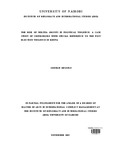| dc.description.abstract | Militias have become an important player in the perpetration of politically instigated
violence. The rise of militia groups as a player in political violence has generated responses from
several quarters, including law enforcement, and civil society. Law enforcement has responded to
the phenomenon of violence through the invocation of laws that prohibit membership of, or
adherence to, proscribed organizations. As a result of this action, militia groups such as Mungiki,
Taliban, Jeshi fa Mzee and Kamjeshi have found themselves proscribed. The other response to
the rise of militia group activity is the rise in academic interest in the activities of such groups. It
is true that there is now an unprecedented interest among academics, in attempting to understand
the organization of these groups and what they portend for the political situation in the country.
This project is a study of the role of militias in the growing problem of political violence
in Kenya, perpetrated in the context of electoral competition. The main thrust of the study is an
investigation into the internal organisation of militias in Kenya, with a view to finding out how
these groups establish and sustain themselves. The study also seeks to establish the relationship
between militias and political players, with a view to explaining the pre-disposition for the use of
these groups in the perpetration of violence. The study further examines the responses that law
enforcement has had towards militias and queries the effectiveness of these in combating
militias. The study selects for examination as a case study the role of chinkororo, a militia group
that operates within the Gusii community in western Kenya, and uses the experiences of this group-to bring out the various aspects of the discourse on millitias in Kenya .
The study is inspired by Kenya's experience of serious political instability, verging civil
war, when the results of the presidential elections held in the country in 2007 were rejected by
the opposition. Although this was by far the worst episode of election-related violence to be
experienced in Kenya, it was not the first one. The elections held in 1992, 1997 and, to some
extent those of2002, were also accompanied by significant amounts of violence.
-The violence which followed the 2007 elections was more severe than any of the
previous incidents of violence, and, although lasting a relatively short period of time, it led to
very considerable humanitarian suffering, the loss of lives and the internal displacement of a
large section of the population. The 2007 political crisis necessitated a mediated settlement, led
by the Panel of Eminent African Personalities constituted by the African Union, and violence
became the subject of official investigation by a commission of inquiry, established as part of the
mediation of the political crisis in the country.
It is hoped that the findings of this study will inform the options that Kenya has to consider for
achieving political stability and overcoming the culture of violence which now threatens the
country's very statehood. | en |

